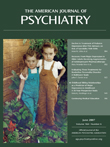Decline in Treatment of Pediatric Depression After FDA Advisory on Risk of Suicidality With SSRIs
Abstract
Objective: In October 2003, the U.S. Food and Drug Administration (FDA) issued a public health advisory about the risk of suicidality in pediatric patients taking selective serotonin reuptake inhibitors (SSRIs) for depression. This study used data from a large national pediatric cohort to examine patterns of diagnosis of depression, prescription of antidepressants, prescription of pharmacological alternatives to antidepressants, and use of psychosocial care before and after the FDA advisory was issued. Method: A large pediatric cohort with newly diagnosed episodes of depression was created from a national integrated claims database of managed care plans from October 1998 to September 2005 (N=65,349). Time-series models were used to compare diagnosing and prescribing trends during the 2 years after the FDA advisory and the expected trends based on data from the 5-year period preceding the advisory. Results: From 1999 to 2004, pediatric diagnoses of depression increased from 3 to 5 per 1,000. After the FDA advisory was issued, the national rate decreased to 1999 levels, a significant deviation from the historical trend. Pediatricians and nonpediatrician primary care physicians accounted for the largest reductions in new diagnoses. Among patients with depression, the proportion receiving no antidepressant increased to three times the rate predicted by the preadvisory trend, and SSRI prescription fills were 58% lower than predicted by the trend. There was no evidence of a significant increase in use of treatment alternatives (psychotherapy, atypical antipsychotics, and anxiolytics). Conclusions: The FDA advisory was associated with significant reductions in aggregate rates of diagnosis and treatment of pediatric depression.



